How to throw the ultimate winter dinner party, according to Scotland’s star chef
Roberta Hall-McCarron knows how to turn a bleak winter night into a celebration. With venison on the stove, candles casting a warm glow and a Paris-Brest waiting to dazzle your guests, the award-winning Scottish chef serves up her blueprint for dinner party perfection. By Hannah Twiggs

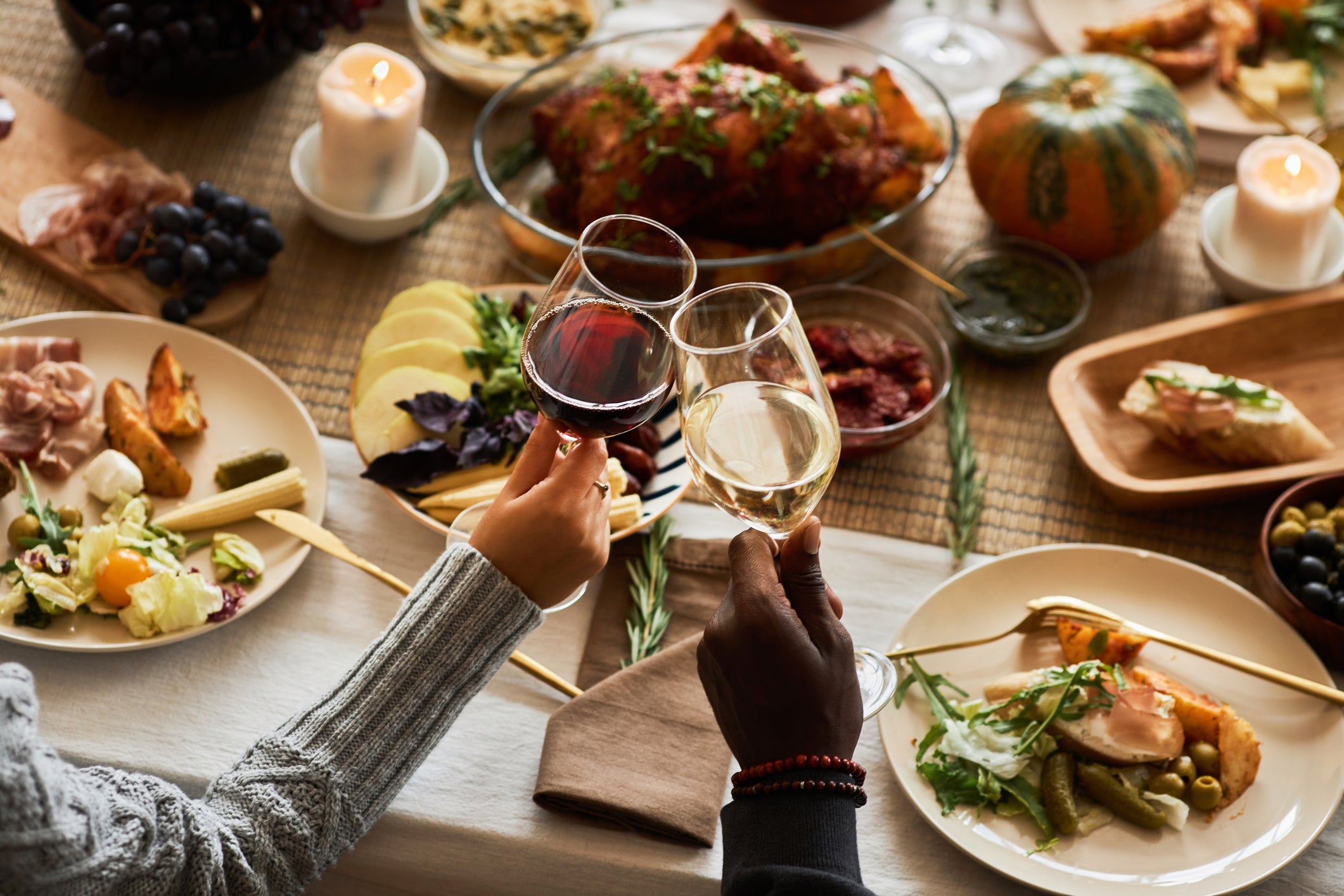
There’s a reason dinner parties take on a particular charm in colder months. When the wind howls, the rain lashes and frost claws its way into your bones, the idea of gathering your favourite people, feeding them until they sigh with contentment feels practically heroic. But let’s face it – most of us are far better at imagining these cosy soirées than actually pulling them off. That’s where Roberta Hall McCarron comes in.
This isn’t your standard Pinterest-level dinner party guru. Hall McCarron is the culinary powerhouse behind Edinburgh’s The Little Chartroom, Eleanore and Ardfern. With a resume that spans Michelin-starred kitchens and a winning appearance on Great British Menu, she knows a thing or two about feeding people. Her debut cookbook The Changing Tides is an ode to Scotland’s finest ingredients, wrapped in a love letter to the seasons. If anyone can guide you through the minefield of hosting an autumn or winter gathering, it’s her.
“Currently, my favourite things to cook are venison, chestnuts, damson and pear, and come January, forced rhubarb,” she says. Not a tin of pre-made jus or a packet of sage-and-onion stuffing in sight. These are ingredients that demand respect, and rightly so. “When the first forced rhubarb comes into the kitchen, we all get very excited as it’s the first bit of colour we’ve had in a few months,” she adds. Her advice? Keep it simple. Let the produce do the work.
It’s not just about the flavour either; it’s about the timing. “I recommend looking at what ingredients are in season because they will always be the freshest and therefore tastiest,” she says. And for those of us who equate “seasonal” with a depressing mound of root vegetables, Hall McCarron is here to set the record straight. Jerusalem artichokes, for one, are your best friend. They’re earthy, versatile and pair beautifully with the kind of hearty dishes you’d want to be served when it’s freezing outside. Lamb pappardelle is her personal favourite: “It’s nourishing and just the sort of thing you need on a cold winter day.”
If the mention of game makes you break out in a cold sweat, fear not. Hall McCarron’s whole roasted partridge with celeriac and greengages is practically foolproof. “People are a bit afraid of cooking game birds,” she acknowledges. “So I’ve made the recipe in the book the opposite so people aren’t put off. All the components can be made ahead; it’s only the cooking of the bird to do at the time, which is quick and simple.” And then there’s her crab thermidor muffin, which sounds decadent to the point of absurdity – because it is.
Seafood lovers will also appreciate her commitment to elevating what the Scottish coast has to offer. From baked fish dishes to curing techniques, her recipes celebrate the natural brininess and freshness of local catches. It’s not just indulgent; it’s deeply personal. Hall McCarron’s food often pays homage to Scotland’s natural beauty, offering guests a taste of the landscape itself.
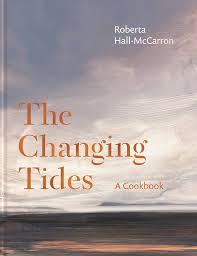
Food, she says, is tied to memory, and some of her fondest memories involve sailing Scotland’s west coast with her father. “My dad had a boat that we’d holiday on when I was younger,” she recalls. “We’d sail up and down the west coast of Scotland and get off the boat to explore the local towns and villages.” It was on one of these trips, in a café in Tobermory, that she first tasted a chocolate fudge cake so good it stayed with her for years. Naturally, she’s reinvented it for The Changing Tides as a chocolate bundt cake with malt chocolate sauce: “Very decadent and delicious, but simple to make. Everything for the cake goes into the bowl together, and then you make the sauce, which is essential!”
If nostalgia is one pillar of Hall McCarron’s philosophy, atmosphere is the other. “Candles and warm, soft light are great for setting the atmosphere,” she says. Drinks, naturally, are equally important. Hall McCarron’s take on winter cocktails is as pragmatic as it is delicious. “Winter cocktails tend to be shorter and boozier – they need to be warming for those coming in from the cold.” Think fruit syrups made from damson or forced rhubarb, paired with the kind of spirits that make you feel like you’ve been hugged from the inside.
For the nervous host, Hall McCarron’s advice is refreshingly straightforward: don’t overcomplicate it. “You have to stay organised, that way you can keep the stress levels down and focus on the guests.” And she’s not talking about the kind of organisation that involves colour-coded spreadsheets. She means practical, time-saving hacks like preparing desserts – trifles, tarts, you name it – ahead of time. Oven-cooked dishes, too, are a lifesaver, allowing you to sidestep the last-minute scramble at the stovetop.
And when it comes to the grand finale, every dinner party needs one. Hall McCarron believes in ending on a high, and her Paris-Brest – a ring of choux pastry filled with praline cream – is just the ticket. “It’s a great way to end the meal and something your guests will definitely remember.”
What makes Hall McCarron’s approach so compelling is that it doesn’t feel out of reach. Sure, she’s got the fine dining credentials, but her focus is on making the seasonal spectacular feel accessible, even for those of us who don’t own a sous-vide machine. Her mantra is simple: quality ingredients, thoughtful preparation and an atmosphere that makes people want to linger at the table.
“Warm hearty food in the middle of the table and good conversation all around,” she says. It’s a philosophy that strips away the fuss and focuses on what really matters: food that brings people together and reminds them why winter isn’t so bad after all.
Venison tartare with smoked celeriac remoulade
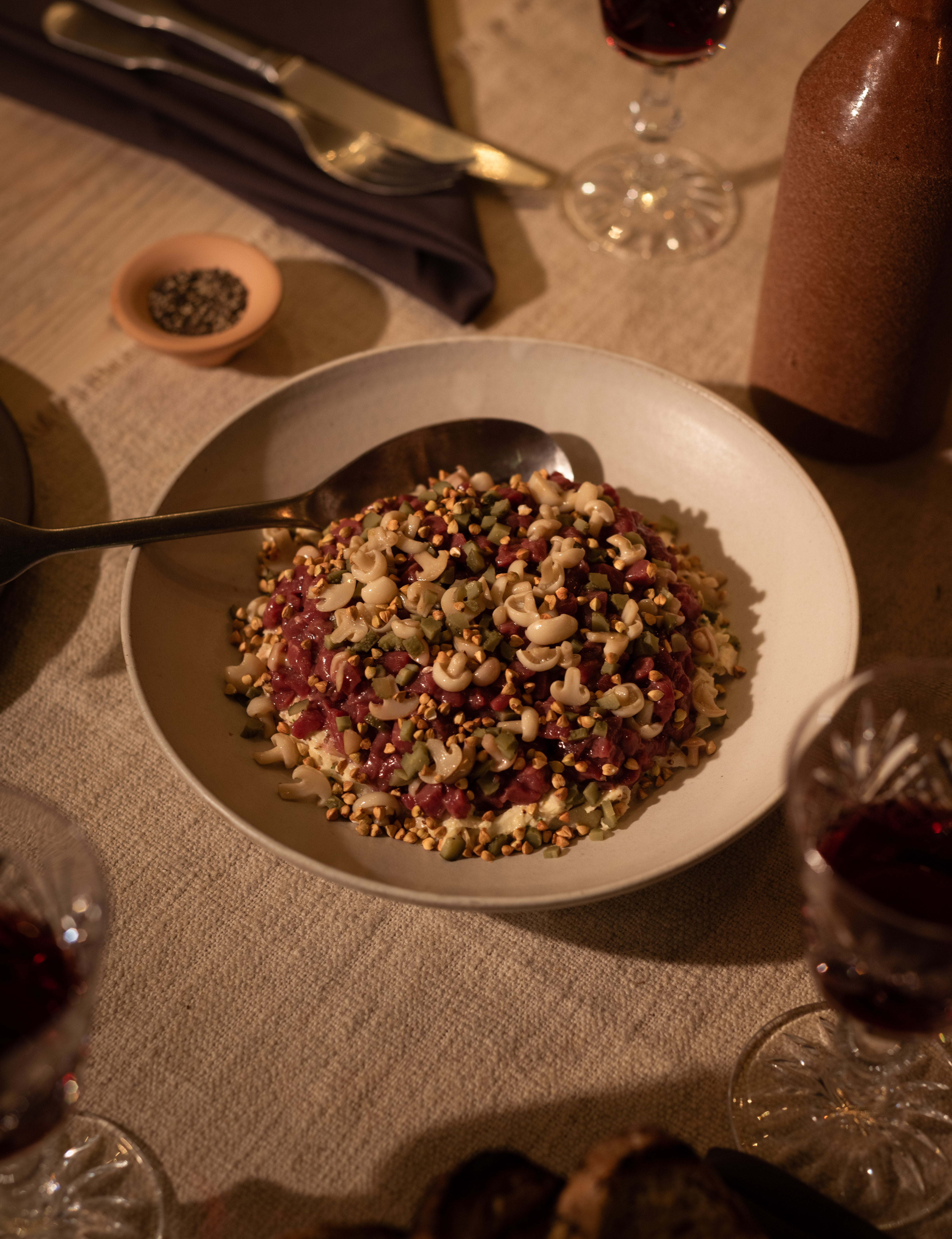
Smoking the remoulade is optional here, but I think it works well with the gamey venison. You just need to get some smoking chips and a smoking table, or alternatively you could make your mayonnaise with a smoked rapeseed oil.
Serves: 6
Ingredients:
1 large (approx 800g) celeriac, peeled and grated
Juice of ½ lemon
2 tsp sea salt
100g mayonnaise
20g Pommery mustard
10g chives, finely chopped
For the venison tartare:
150g shimeji mashrooma
200ml pickle liquor
80g cornichons
300g venison haunch or fillet
1 tbsp good-quality olive oil
2 tsp sea salt
25g buckwheat, toasted
6 slices of sourdough bread
Method:
1. For the remoulade, mix the grated celeriac with the lemon juice and salt and leave for 10 minutes until it has wilted slightly. Add the mayonnaise, Pommery mustard and finely chopped chives and stir through so everything is well mixed. If you’re smoking the remoulade, smoke it for 15 minutes.
2. Next, make the tartare. Using scissors, trim the shimeji mushrooms, leaving about 1cm of the stalk on and put them in a bowl. Warm 100ml of the pickle liquor and pour it over the mushrooms. Set aside to cool.
3. Half the cornichons lengthways, then cut into thin slices about 2 or 3mm thick.
4. Trim any sinew off the venison and discard, then cut the meat into 1cm pieces and put it into a bowl. Mix the remaining pickle liquor with the olive oil and stir it through the diced venison. Add the salt, taste and add a little more if needed.
5. Strain the pickled shimejis through a sieve. Spread a generous amount of celeriac remoulade on your serving plate. Cover it with the venison, then scatter over the cornichons, pickled shimejis and toasted buckwheat.
6. Chargrill the sourdough and serve alongside the tartare.
Baked John Dory with seaweed Jersey Royals
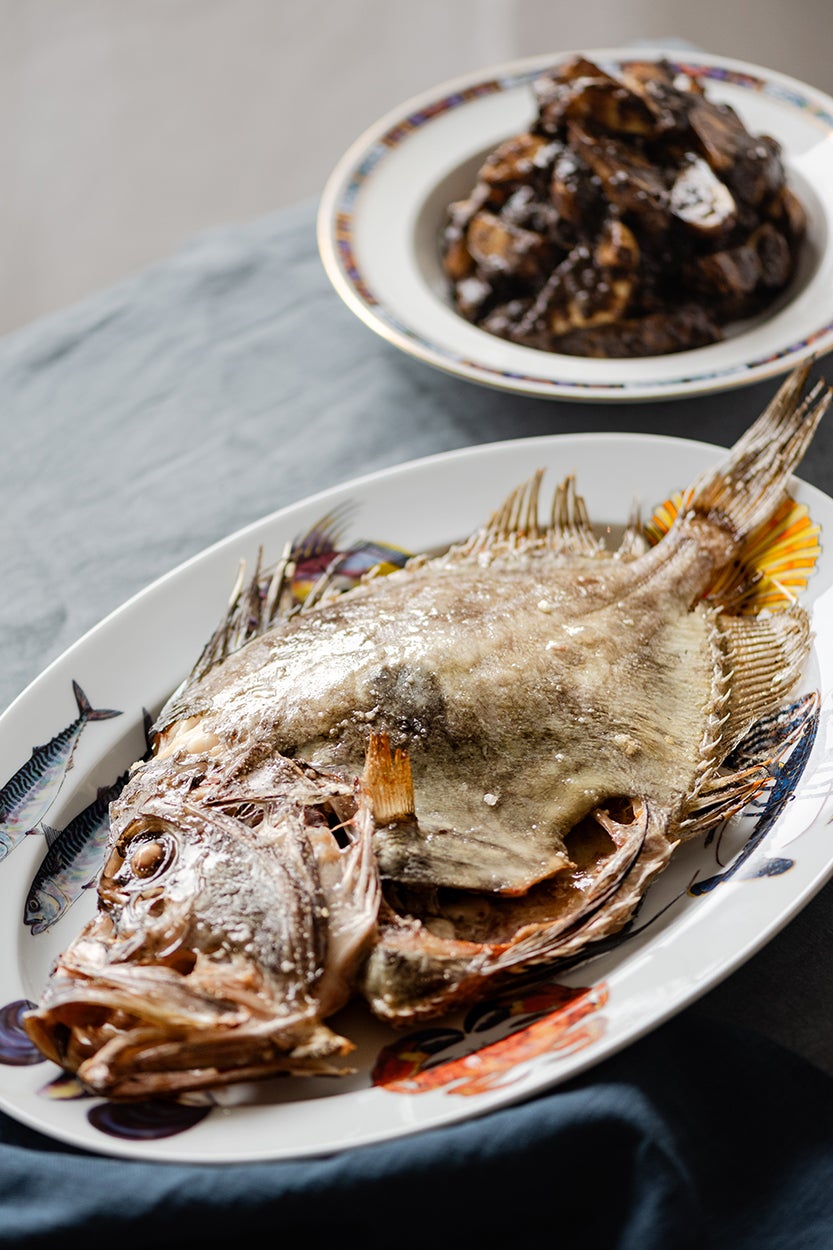
John Dory is one of my favourite fish; it has a really unique flavour. This is a very simple dish that allows the produce to shine.
Serves: 4
Ingredients:
1 John Dory, weighing about 1kg
1 tbsp sunflower oil
Sea salt
For the seaweed jersey royals:
500g Jersey royals
1 tbsp fine salt
2 banana shallots, finely diced
Sunflower oil
25g nori sheets
1 tbsp rice vinegar
½ tbsp honey
½ tbsp soy
Method:
1. Preheat your oven to 200C fan.
2. Rub the John Dory all over with oil and season with sea salt. Place it on a greaseproof paper-lined tray and bake in the oven for 20 minutes.
3. Pop the Jersey royals and a tablespoon of salt in a pot and cover with cold water. Bring to a simmer and cook for 20 minutes until the potatoes are tender.
4. Sweat the shallots in a little oil for a few minutes, until nice and soft. Blitz the nori sheets and add to the shallots, then stir in the rice vinegar, honey and soy. Simmer for 5 minutes, until most of the liquid has evaporated.
5. Drain the potatoes, reserving the cooking water, and if they’re big cut them into quarters. Mix them with the nori purée, adding a little of the potato cooking water if the purée needs loosening.
6. Put the John Dory on to a serving plate and pull off the skin so everyone can get at the soft white flesh. Serve the seaweed potatoes alongside.
Sweet eggy bread and poached pears
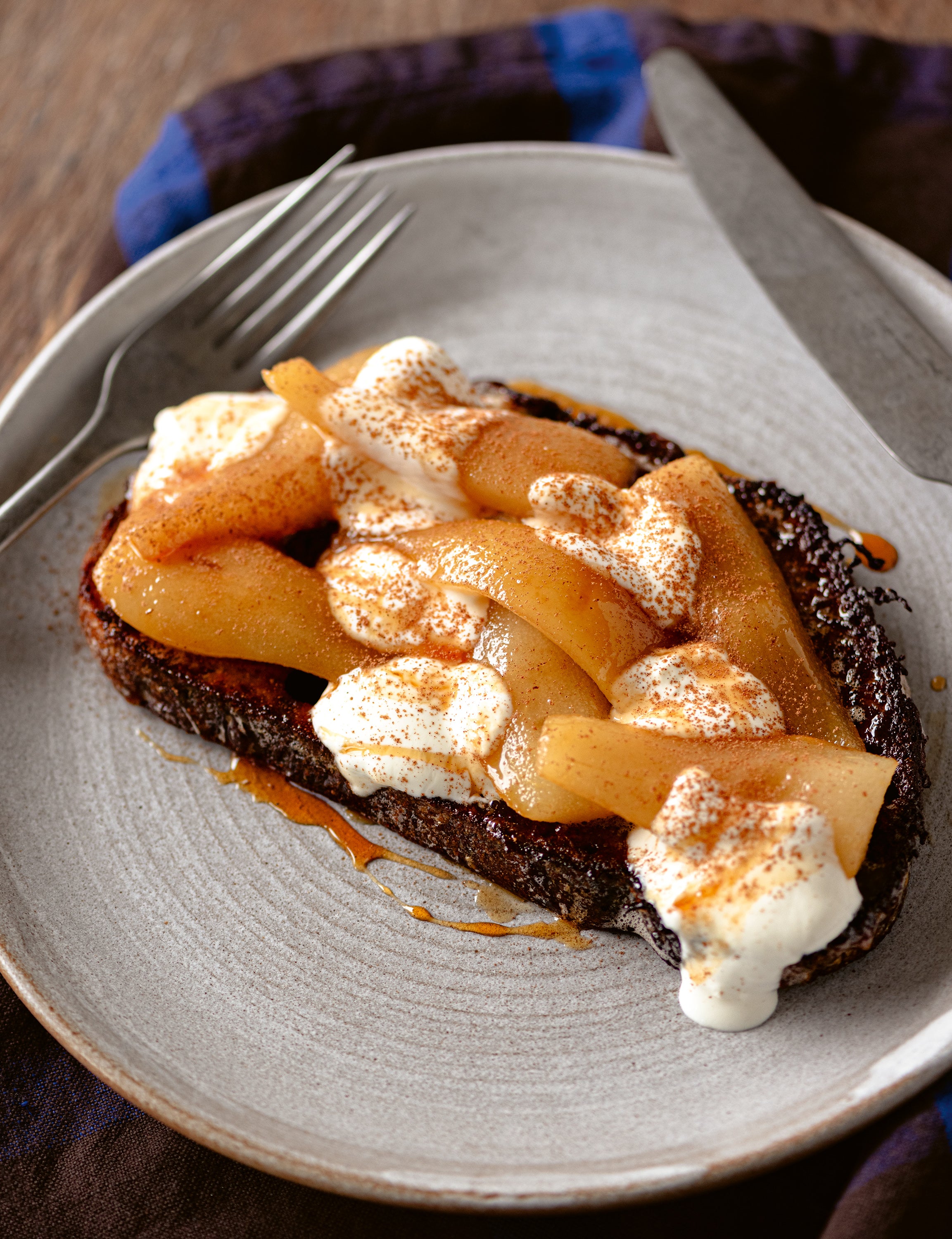
There’s something really nice about getting stuck in to sophisticated kids’ food on a cold winter's morning.
Serves: 4
Ingredients:
For the poached pears:
1l pear juice (or use apple if you can't find pear)
2 star anise
1 cinnamon stick
6 pears, peeled, cored and quartered
For the eggy bread:
4 eggs
100ml whole milk
30g sugar
1½ tsp vanilla extract
1½ tsp cinnamon
4 slices of sourdough bread
1 tbsp butter
To serve:
200g natural yoghurt ground cinnamon
Method:
1. In a large pot, warm the juice, star anise and cinnamon stick over a medium heat.
2. Submerge the prepared pears in the pear juice and bring up to a simmer, then cook gently for 5 minutes. Check a piece to see if it’s done – you want it to be just tender – and if necessary simmer for a little longer, keeping an eye out as they can easily overcook.
3. Remove the pears from the juice with a slotted spoon and, once they’ve cooled a bit, cut them in half lengthways. Reduce the juice down until it is syrupy, then discard the star anise and cinnamon.
4. In a flattish bowl, whisk the eggs, milk, sugar, vanilla and ground cinnamon together. One by one, dunk the slices of bread in the mix for a minute, turning a couple of times so they are soaked through. Melt the butter in a frying pan and fry the eggy bread over a medium-high heat until golden brown all over, about a minute on each side.
5. Pop the pears back in the reduced syrup and warm them through. Arrange them on top of the eggy bread with a good dollop of yoghurt and plenty of the syrup, then dust over some cinnamon.
Recipes from ‘The Changing Tides: A Cookbook’ by Roberta Hall-McCarron (Kitchen Press, £25).






Join our commenting forum
Join thought-provoking conversations, follow other Independent readers and see their replies
0Comments